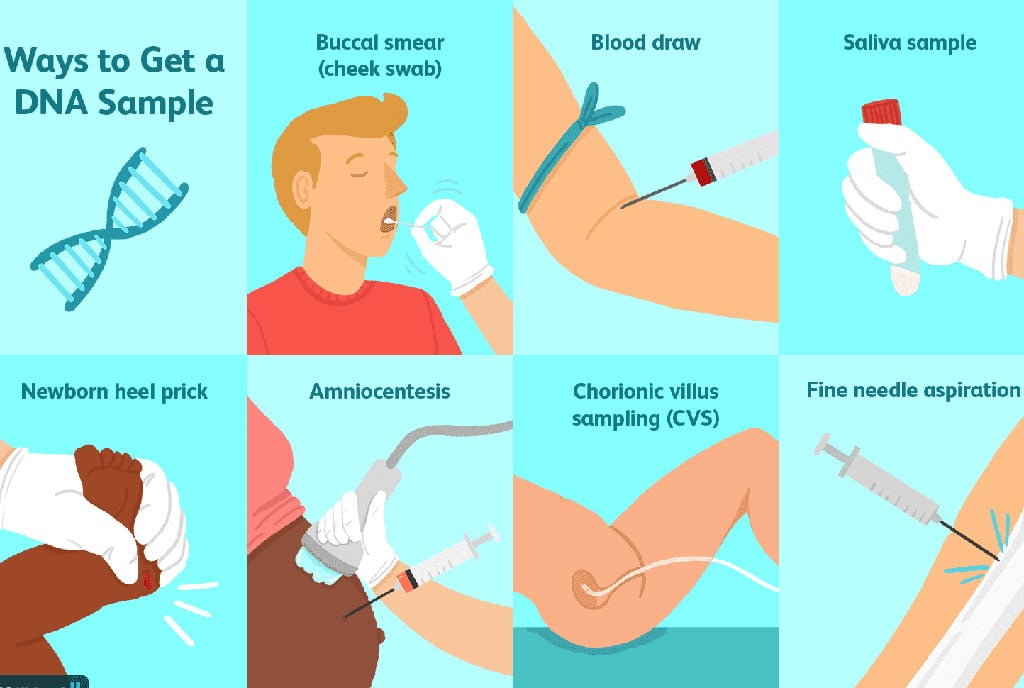Prime
What you should know before taking DNA test

Ways to get a DNA test. PHOTO/COURTESY
What you need to know:
- Other uses. While the public today is only conscious of DNA testing where the paternity of a child is in question, there are some other cases where DNA testing is used.
Deoxyribonucleic acid (DNA) is the molecule that carries genetic information for the development and functioning of an organism. It contains units of biological building blocks called nucleotides, which make the genes that are inherited or passed from parents to their children and are responsible for all unique characteristics of living things, including human beings.
It is also responsible for passing on traits from parents to children and can be used to accurately separate biological relationships between organisms. DNA also carries information for the colour of the skin, eyes, height, body size and all other unique features of an individual. Each information is carried in three pairs of nucleotides (bases).
According to Dr Moses Ocan, a senior lecturer at Makerere College of Health Sciences, a DNA test establishes that the particular pairs of nucleotides responsible for unique features of an individual can be used to trace one’s parents; mother (maternal) or father (paternal).
Each of the parents contributes half of the nucleotides responsible for each characteristic of a child. Therefore, by taking samples (either piece of skin, hair and mouth swab, among others) from the alleged father or mother and the child in question, a DNA test can help confirm the real parents of the child.
“If the alleged individual is the father or mother of a child in question, the DNA results should match up 99 to 100 percent. In the case of first degree relatives, if the person is a true brother or sister of your father or mother from the same parents depending on the test done, the results should also match,” he says.
Timeline
It can take between three to five working days or 12 to 24 hours to get your DNA results after collecting your samples but the latter may be more costly. DNA testing costs $100 (about Shs385,000) at MBN Laboratories in Kampala, but the cost can be higher for postmortem, Y- chromosomal testing and immigration DNA testing.
“The samples are usually collected as blood samples or mouth swabs or any other parts of the body of the father or mother and the child in question. You will also be asked for a passport size photograph and a signed and dated copy of a state-issued ID document bearing a photo such as the National ID, passport or driving permit,” Dr Ocan says.
Can a child belong to more than one father?
According to Dr Ocan, the body has two types of cells; the germ and somatic cells. The germ cells participate in reproduction and are contained in the sperm and ova.
The somatic cells are found in other parts of the body as a result of the union of germ cells (ova and sperm). At fertilisation, different cells, tissues and organs are formed from a series of multiple cell division events guided by information in the DNA.
“The ovum has a mechanism that allows only one sperm to unite with it at fertilisation. Therefore, two sperms cannot fertilise the same egg at the same time. When one sperm comes in contact with the zona pellucida layer of the ova, changes in the membrane prevent further entry of sperms,” says Dr Ocan.

A doctor explains to a client DNA result. PHOTO/FILE
Two sperms fertilising the same ova is rare and embryos usually do not survive. However, Dr Henry Bukenya, a surgeon at Bombo General Military Hospital, says two sperms can enter two different eggs at the same time in a condition known as bipaternalism or heteropaternal fecundation.
“A woman can ovulate twice in the same menstrual cycle and the eggs remain viable for about 24 hours. If she has intercourse with two different men, they can both be fertilised on the same day, resulting in twins with different fathers,” he says.
There are also incidents of chimerism, a rare congenital abnormality where one foetus swallows another in the uterus. When such a child is born, they can have two DNAs, including that of their twin. They can also both stay alive but their chromosomes can be traded and at birth, they have two similar DNAs.
However, there are times of random occurrences in the DNA where nucleotides are changed, or replaced. This is called mutation and can result in mismatch during DNA testing and thus, affect the results.
Other uses of DNA
While the public today is only conscious of DNA testing for paternity tests (where a father of a child is in question), there are some other cases where DNA testing is used.
For example, it can be used to detect infectious diseases such as HIV, tuberclosis, Covid-19 and Ebola. It can also be used to predict the risk of developing certain diseases such as cancers and to guide treatments.

DNA tests serve various purposes other than confirming paternity. PHOTO/FILE
DNA can also be used to determine the paternity and maternity of a child who is suspected to have been switched at birth in the hospital or as required during immigration processes to confirm biological relationships between potential immigrants.
The big problem
According to Dr Jane Ruth Aceng, the minister of health, DNA paternity testing has been ongoing in the country for close to 20 years. It is also routinely used to resolve paternity and kinship disputes.
However, the social media reports of child neglect homicide and even suicide following the issuance of negative paternity tests have created the impression of a DNA paternity testing crisis in the country.
As a result, the public has gone further to question the validity and integrity of DNA paternity testing results, credibility of the persons and laboratories conducting the test.
“The government took a keen interest in the matter and conducted a consultative meeting with different government ministries, departments and agencies alongside the testing laboratories to resolve the situation,” she says.
After thorough research and a preliminary review of data, the government certified only two laboratories in the country; The Government Analytical Laboratory (GAL) and MBN clinical laboratory.
According to the minister, research indicated that seven out of 10 paternity disputes that sought DNA testing turned out to be positive biological relationships and only three out of 10 and negative relationships confirming the grounds of dispute.
“About 30 percent of fathers with unmatched results had no social issues of child rejection homicide or suicide. This could partly be attributed to the fact that results were professionally communicated. The media incidents may, therefore, point to mental health disturbance of parties involved; probably due to poor communication as a result of some service providers as well as social media sensationalism. However, I want to reassure Ugandans that there is no paternity crisis in the country,” Dr Aceng says.

Health minister Jane Ruth Aceng (left) and government scientist Misaki Wayengera during a press conference in Kampala on July 10, 2023. Operators of private laboratories questioned the criteria the ministry used to zero down on only two laboratories to conduct DNA paternity tests. PHOTO/FRANK BAGUMA
Several other laboratories in Uganda are also accredited and certified to do DNA testing for diagnostic and research purposes such as investigating trends in covid-19 tuberclosis, HIV, Sickle cell, Hepatitis B and cancers.
These are the central public health laboratories (CPHL) National TB Reference Laboratory (NTRL) Joint Clinical Research Centre (JCRC) and laboratories at Uganda Virus Research Institute (UVRI), Makerere and Mbarara universities.
Authentic results
DNA testing is a complex procedure that requires sophisticated technology, highly skilled personnel and infrastructure. Even sample collection requires skilled handling since any contamination can lead to issuance of false results. This is why the testing, including sample collection, is restricted.
MUST READ: DNA affected men narrate ordeals
Dr Ocan remarks that DNA testing for relationships reveals sensitive information about an individual and, therefore, data needs to be handled in an ethical manner with due regard to the security of the individuals as well.
Even more important is that DNA testing for relationships touches the core of society, which is the family. It is, therefore, a matter that cannot be handled lightly.
“When carrying out a DNA test, it is important that the test samples are collected carefully to avoid any errors. In the laboratory, there are a lot of control measures that are done and by the time the results are released, they have been verified and confirmed,” he says.
The matter of DNA tests is a very sensitive issue because of its potential outcomes on a couple’s marriage and the impact it can have on the children, it is important that the request for one to have such a test done comes from an authentic source such as courts of law, community leaders, administrator general, probation office, religious institution or parents who have consented.
“Delivering results should be done in a professional way that includes pre-counselling of the parents and the child if they are mature enough to comprehend the matter. In all things, it is important to protect the child from all sorts of violence and psychological implications that can come due to the results,” Dr Ocan advises.
If one is not satisfied with the results, they can request for the test to be repeated or go to another laboratory for a second opinion.
Additional interventions
According to health minister Dr Jane Ruth Aceng, the government plans to develop and implement guidelines to streamline DNA testing to ensure quality, legal, ethical and professional practices are adhered to, and psychosocial structures are available to support the pre and post DNA test counselling services.

No laboratories and clinics shall be allowed to collect samples for DNA testing unless they have agreements with the accredited lab and the same shall take full accountability of the results.
“Any laboratory that is prepared and wants to do DNA testing can apply to the director general of health services who will set up a team of experts to assess the laboratory for certification,” she says.




